Do you ever notice that sometimes when we light a candle, the wick seems to vanish into the melted wax? Fear not! We have some simple tips to prevent this annoying issue.
Keeping a candle wick from drowning is all about proper care and attention. By choosing the right size wick, trimming it before each use, and positioning it correctly in the candle, we can ensure a clean and steady burn.
Using a wick trimmer or scissors for trimming, avoiding drafts and air currents, and keeping the candle away from flammable materials are also key steps in preventing wick drowning.
Additionally, storing candles in a cool, dry place and following the manufacturer’s instructions will help us achieve optimal burning.

Let’s dive in and discover how to keep our candle wicks afloat!
Key Takeaways
- Proper wick selection and trimming are essential to prevent wick drowning.
- Positioning the wick correctly in the center of the candle helps prevent drowning in wax.
- Using wick trimming tools like scissors or wick trimmers helps maintain the correct wick length.
- Paying attention to proper burning techniques and preventing wax build-up can also prevent wick drowning.
Choose the Right Size Wick
How do we determine the appropriate size wick to prevent a candle from drowning?
Choosing the proper wick size is crucial in ensuring a well-functioning and long-lasting candle. To select the right wick, there are a few key tips to keep in mind.
First, consider the diameter of your candle. A larger candle will require a thicker wick to provide enough heat for a complete burn. On the other hand, a smaller candle will need a thinner wick to prevent excess smoke and soot.

Additionally, the type of wax you’re using can also impact wick selection. For softer waxes, a larger wick may be necessary to compensate for slower burn rates.
Lastly, it’s important to experiment and test different wick sizes to find the perfect fit for your specific candle-making process.
Trim the Wick Before Each Use
Before each use, we should trim the wick using a pair of scissors or wick trimmers to ensure optimal burning conditions. Wick trimming tools are essential for maintaining a clean and efficient burn.
Here are some benefits of keeping the wick trimmed:

- Extended candle life: Trimming the wick prevents excess smoke and soot, allowing the candle to burn longer.
- Reduced mushrooming: A trimmed wick reduces the formation of mushroom-like carbon deposits, which can cause the flame to flicker and produce black soot.
- Enhanced scent throw: By keeping the wick trimmed to the recommended length, the candle’s fragrance will disperse more evenly, filling the room with a pleasant aroma.
Regularly trimming the wick not only improves the candle’s performance but also promotes safety by minimizing the risk of accidental fires.
Position the Wick Correctly in the Candle
Now let’s talk about the importance of positioning the wick correctly in the candle to prevent it from drowning.
The way the wick is placed in the candle plays a crucial role in its ability to burn efficiently. Placing the wick too close to the edge can cause it to drown in the melted wax, resulting in a weak flame and wasted candle wax.
Wick Placement Importance
We position the wick correctly in the candle to ensure optimal burning and prevent drowning. Proper wick placement is crucial for maintaining a steady flame and preventing issues like wick curling.
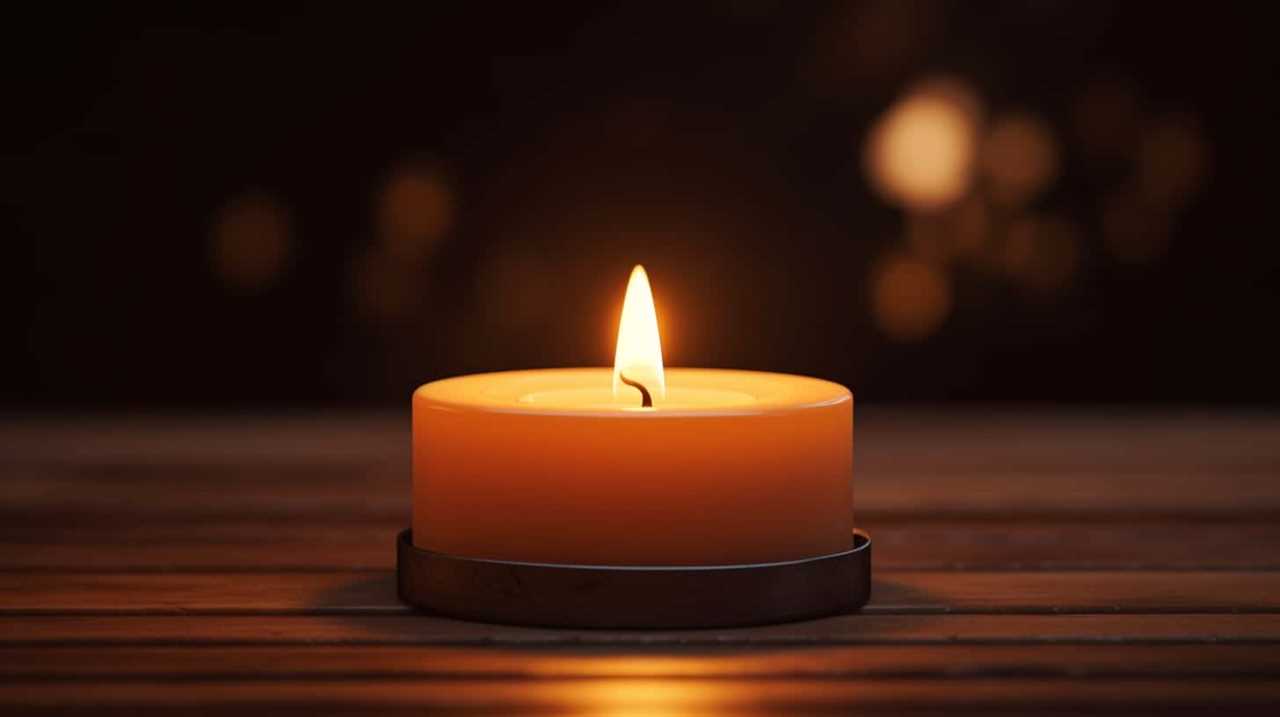
Here are some key considerations for placing the wick in your candle:
- Center the wick: Placing the wick in the center of the candle ensures an even burn and prevents the wax from accumulating on one side, which can lead to an uneven and unstable flame.
- Trim the wick: Before lighting the candle, trim the wick to about ¼ inch to prevent excessive flickering and soot formation. This helps maintain a clean burn and prolongs the candle’s lifespan.
- Avoid touching the container: Ensure that the wick isn’t touching the sides or bottom of the container, as this can cause the wick to drown in the melted wax. Use a wick holder or centering device if needed.
Preventing Wick From Drowning
To prevent the wick from drowning in the melted wax, it’s important to position it correctly in the candle. Proper wick maintenance is essential for preventing wax buildup and ensuring a steady, even burn.
When placing the wick, make sure it’s centered in the candle and stands upright. Avoid placing the wick too close to the edge of the container, as this can cause uneven burning and potential drowning.
Trim the wick to about 1/4 inch in length before lighting the candle. This will help control the size of the flame and prevent excessive wax from pooling around the wick.

Use a Wick Trimmer or Scissors for Trimming
To ensure a candle wick doesn’t drown, it’s important to maintain a proper wick length. Using a wick trimmer or scissors is an effective way to achieve this.
Proper Wick Length
For a candle wick to burn efficiently and avoid drowning, it’s crucial to maintain a proper wick length by using a wick trimmer or scissors for trimming. Proper wick maintenance plays a vital role in preventing wick curling, which can hinder the candle’s performance.
Here are three reasons why maintaining the right wick length is essential:
- Improved Burn Time: Keeping the wick trimmed to the correct length ensures a steady and consistent flame, allowing the candle to burn evenly and last longer.
- Reduced Soot and Smoke: A properly trimmed wick minimizes the amount of soot and smoke produced during burning, creating a cleaner and healthier environment.
- Enhanced Fragrance Release: By maintaining the correct wick length, you can optimize the fragrance release of scented candles, ensuring a more enjoyable and aromatic experience.
With proper wick length established, let’s now explore preventing wick extinguishment.

Preventing Wick Extinguishment
To prevent wick extinguishment and ensure optimal candle burning, we recommend using a wick trimmer or scissors for regular trimming.
Preventing wick smoldering is essential for maintaining a steady flame and preventing the candle from going out prematurely. One of the most common wick extinguishing mistakes is allowing the wick to become too long.
When the wick is too long, it can create a large flame that consumes the wax faster and increases the risk of the wick smoldering and going out.
Avoid Drafts and Air Currents
Avoiding drafts and air currents is key to preventing a candle wick from drowning. When it comes to candle care, it’s important to create a stable environment for your candle to burn. Here are some reasons why you should avoid drafts and air currents:

- Preserve the flame: Drafts can cause the flame to flicker and dance, which increases the likelihood of the wick being extinguished.
- Prevent uneven burning: Air currents can disrupt the even burning of the candle, leading to uneven wax consumption and a short lifespan.
- Maintain candle fragrance: Scented candles rely on a steady burn to release their fragrance properly. Drafts can diminish the scent throw, resulting in a less enjoyable experience.
By avoiding drafts and air currents, you can ensure that your candle burns consistently and efficiently.
Now let’s talk about the next step: burning the candle for a sufficient amount of time.
Burn the Candle for a Sufficient Amount of Time
Now let’s talk about the importance of burning a candle for a sufficient amount of time.
When you light a candle, it’s crucial to let it burn long enough to create a full melt pool across the surface. This ensures an even burn and prevents tunneling.
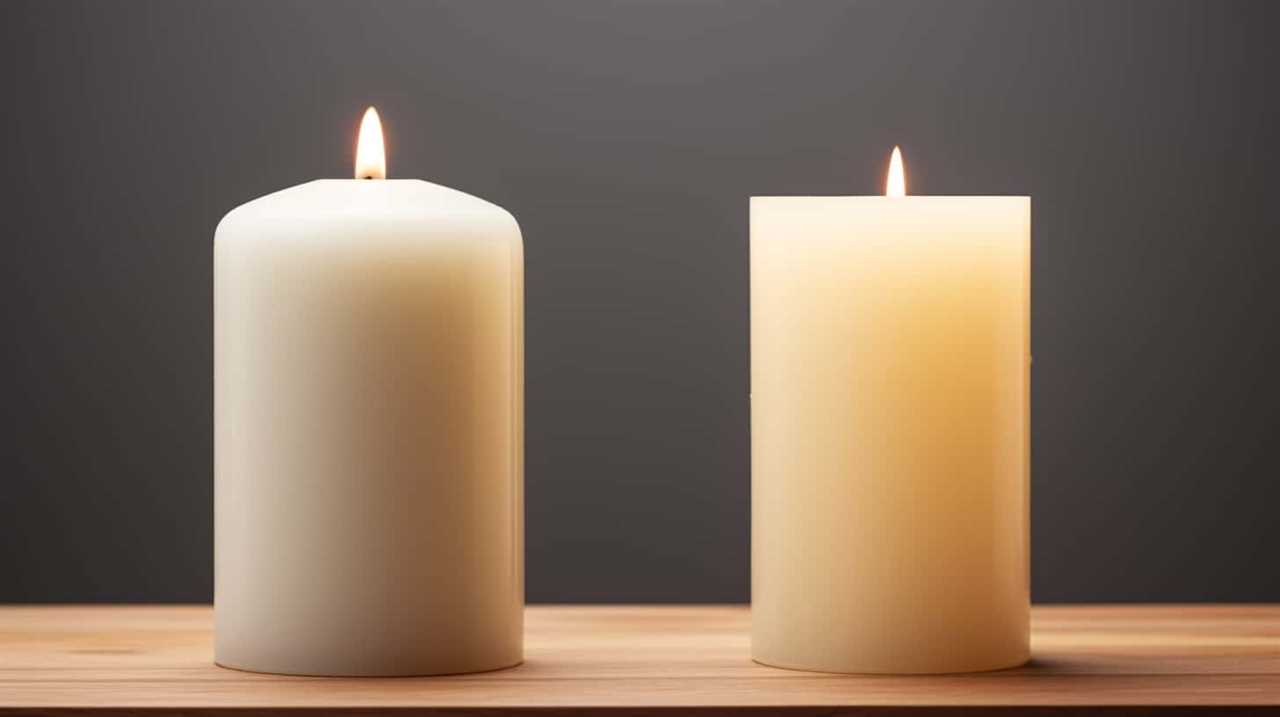
Additionally, regularly trimming the wick to 1/4 inch before each use will help maintain a steady flame and prevent excessive soot or mushrooming.
Proper Burn Time
Our recommended approach for achieving a proper burn time and preventing the drowning of a candle wick is to ensure that we burn the candle for a sufficient amount of time. By following this candle safety precaution, we can enjoy our candles without any worries.
Here are some key reasons why proper burn time is crucial:
- Enhances fragrance release: Burning the candle for a sufficient amount of time allows the fragrance to disperse evenly, filling the room with a beautiful scent.
- Prevents tunneling: If we don’t burn the candle long enough, it can cause tunneling, where the wax doesn’t melt evenly. This not only wastes the candle but also prevents it from burning properly in the future.
- Maximizes candle lifespan: Burning the candle for the recommended amount of time ensures that we get the most out of our candles, allowing us to enjoy them for longer.
Wick Maintenance Tips
To ensure a sufficient burn time and prevent the drowning of a candle wick, we must prioritize proper maintenance.

One important aspect of wick care is to burn the candle for a sufficient amount of time each time you light it. This means allowing the candle to burn long enough for the entire top layer of wax to melt into a pool of liquid wax. By doing so, you prevent the formation of a wick mushroom, which can obstruct the flow of oxygen to the flame and lead to poor burning performance.
Additionally, burning the candle for a sufficient amount of time helps to prevent the buildup of excess wax around the wick, which can also impede the proper burning process.
Preventing Wax Build-Up
To prevent the build-up of wax around the wick, we must ensure that the candle burns for a sufficient amount of time each time it’s lit. This is crucial in preventing wax overflow and maintaining the optimal wick length. Here are some tips to help you achieve this:
- Burn the candle for at least 1 hour for every inch in diameter. This allows the wax to melt evenly and prevents tunneling.
- Avoid extinguishing the candle too soon. If you blow it out before the wax has fully melted to the edges, a tunnel may form, leading to wasted wax.
- Trim the wick to 1/4 inch before each burn. A longer wick can cause the flame to burn too hot, resulting in excessive wax consumption.
Use a Candle Snuffer for Extinguishing
We recommend using a candle snuffer to extinguish the flame. Candle snuffers are a practical and efficient tool for safely putting out candles. They offer several benefits over other candle snuffer alternatives, such as blowing out the flame or using a damp cloth.
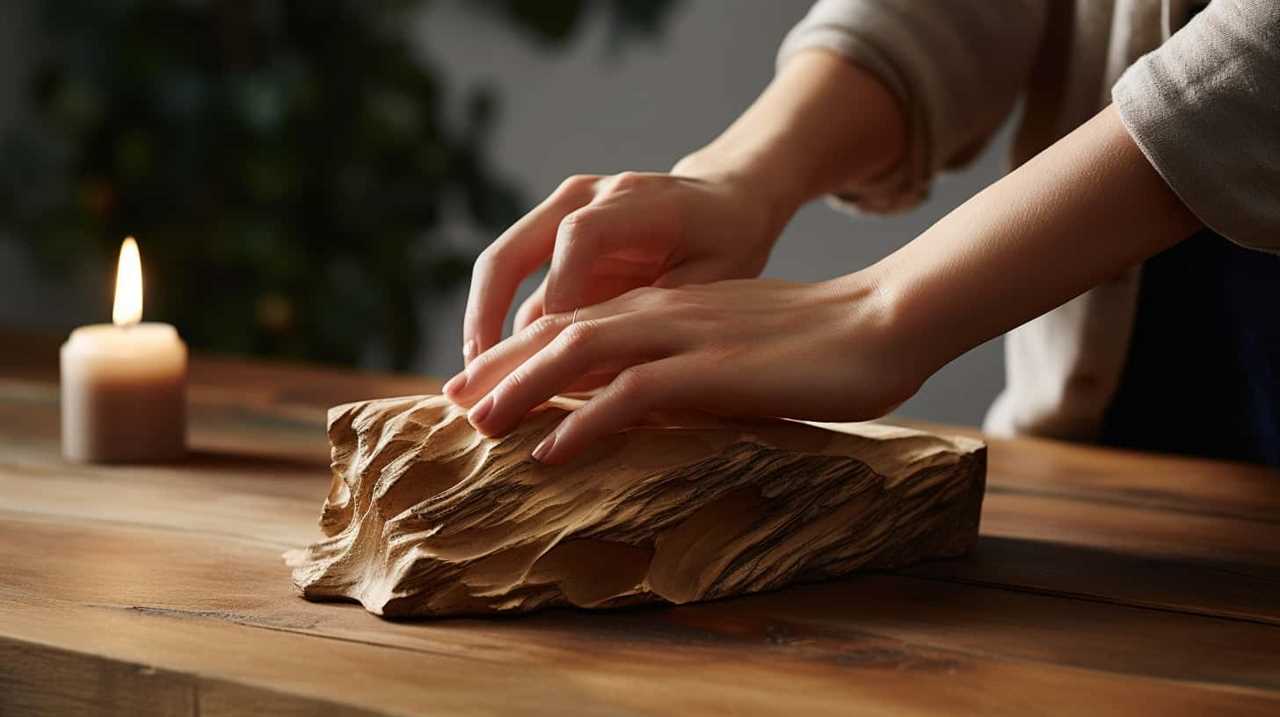
Here is a table highlighting the benefits of candle snuffers:
| Benefits of Candle Snuffers |
|---|
| Safe and controlled extinguishing |
| Prevents wax splatter |
| Minimizes smoke and soot |
| Preserves the integrity of the wick |
By using a candle snuffer, you can ensure a safe and enjoyable candle experience without the risk of accidentally spilling wax or creating a mess.
Next, let’s explore another important aspect of candle safety: avoiding placing the candle near vents or fans.
Avoid Placing the Candle Near Vents or Fans
When it comes to candle safety, proper placement is crucial. Avoid placing candles near vents or fans as the air circulation can cause the flame to flicker and potentially lead to uneven burning or even extinguishment.
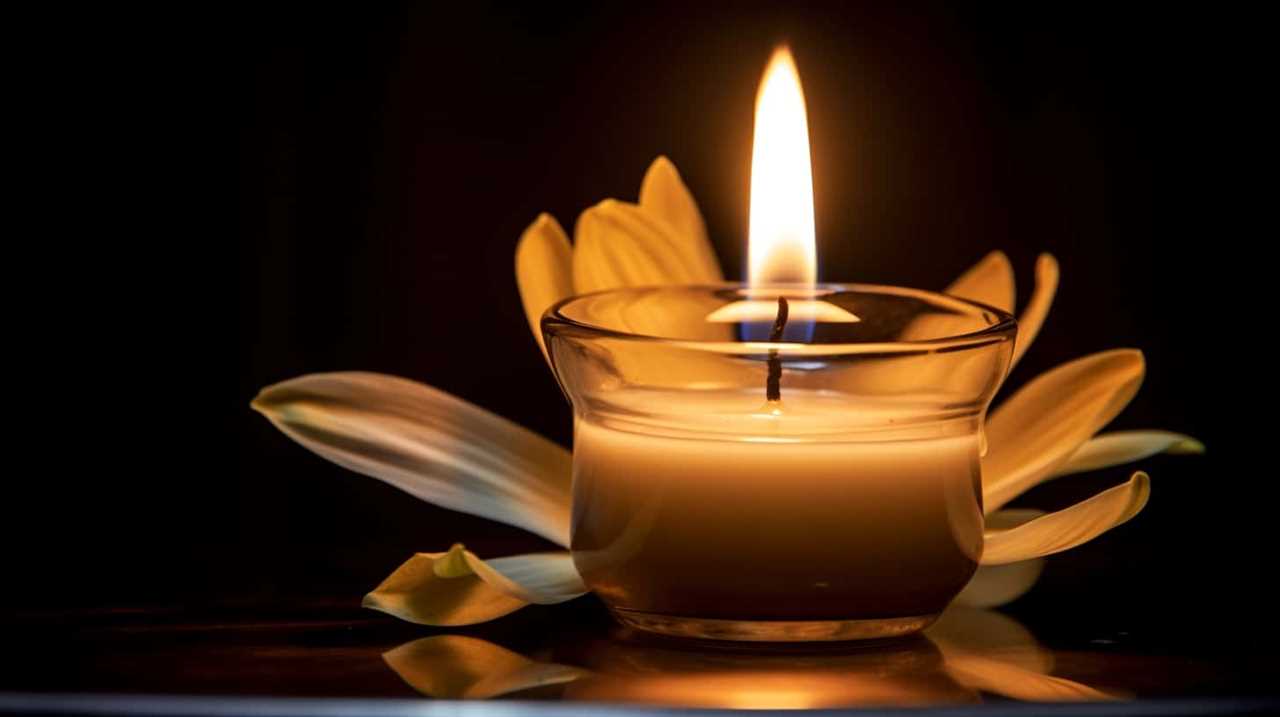
Proper Candle Placement
Placing the candle near vents or fans can hinder the proper burning of the wick. When the air from the vents or fans blows directly onto the flame, it disrupts the airflow around the candle, causing the wick to burn unevenly or extinguish prematurely. To prevent wick issues and ensure a clean, steady burn, it’s important to consider the placement of your candles.
Here are a few reasons why you should avoid placing the candle near vents or fans:
- Maintain a steady burn: Air circulation from vents or fans can cause the flame to flicker, leading to an inconsistent burn and potentially extinguishing the candle.
- Prevent sooting: When the flame is disrupted by air movement, it can create soot, which can stain the candle container and release harmful particles into the air.
- Minimize fire hazards: Placing candles near vents or fans increases the risk of accidental fire due to the potential for the flame to come into contact with nearby objects.
To ensure your candle burns optimally, it’s crucial to avoid placing it near vents or fans.
Now let’s explore another important aspect of proper candle placement – minimizing air circulation.

Minimizing Air Circulation
To maximize the burn time and prevent wick issues, it’s important to ensure that candles are not placed near vents or fans, as this can disrupt the airflow and cause uneven burning or premature extinguishing. When a candle is exposed to a strong air current, such as those produced by vents or fans, it can lead to an imbalance in the way the flame burns. This can result in an uneven melting of the wax and a shorter burn time. Additionally, strong air circulation can cause the flame to flicker or even go out completely. To avoid these issues and maximize fragrance diffusion, it is recommended to keep candles away from any source of direct air flow. This simple candle safety precaution will help you enjoy your candles for longer and enhance their aromatic experience.
| Pros | Cons |
|---|---|
| Longer burn time | Uneven melting of wax |
| Maximum fragrance diffusion | Flame flickering or extinguishing |
| Enhanced aromatic experience |
Opt for Candles With Wider Containers
Choosing candles with wider containers can help prevent the wick from drowning. When it comes to candle container options, wider containers offer several benefits:
- Improved air circulation: Wider containers allow for better airflow around the wick, reducing the chances of it getting suffocated by the melted wax.
- Longer burning time: With more space for the flame to breathe, candles with wider containers tend to burn more efficiently, resulting in a longer-lasting candle.
- Reduced soot and smoke: Adequate air circulation helps minimize the production of soot and smoke, creating a cleaner and healthier environment.
By opting for candles with wider containers, you can ensure that your candle burns evenly and lasts longer, while also reducing the risk of the wick drowning.
Use a Candle Accessory to Hold the Wick Upright
To ensure that the candle wick remains upright and prevents drowning, we can utilize a candle accessory.

Candle wick accessories are designed specifically to hold the wick in place, preventing it from sinking into the melted wax and causing the flame to extinguish.
There are various types of candle accessories available in the market, such as wick holders, wick clips, and wick stabilizers.
These accessories work by providing support to the wick, keeping it centered and upright as the candle burns.
By using a candle accessory, you can ensure that the wick stays above the level of the wax, allowing it to burn evenly and preventing wick drowning.

This not only enhances the candle’s performance but also prolongs its lifespan.
Avoid Burning Candles in Very Small Spaces
We recommend avoiding burning candles in very small spaces to prevent the risk of wick drowning and ensure safe candle burning. When candles are lit in confined areas, the limited air circulation can cause the flame to burn unevenly and create excessive heat. This can lead to the wick drowning in melted wax, hindering its ability to burn properly. To maintain the wick and prevent wax build up, it’s important to provide adequate space around the candle.
Here are three reasons why burning candles in small spaces should be avoided:
- Limited air circulation can cause the flame to flicker and burn inconsistently.
- Excessive heat in small spaces can increase the risk of fire hazards.
- The lack of space can make it difficult to monitor the candle and prevent accidents.
Keep the Candle Away From Flammable Materials
To prevent the risk of fire, it is important to keep the candle away from any flammable materials. Placing the candle near items such as curtains, paper, or other combustible substances greatly increases the chance of a dangerous fire. It is crucial to keep the candle in a well-ventilated area, away from any potential sources of ignition. Additionally, it is essential to avoid using candles near children or pets, as they may accidentally knock over the candle or come into contact with the flame, leading to serious injuries or accidents. By following these precautions, you can enjoy the warm glow of a candle while ensuring the safety of your home and loved ones.
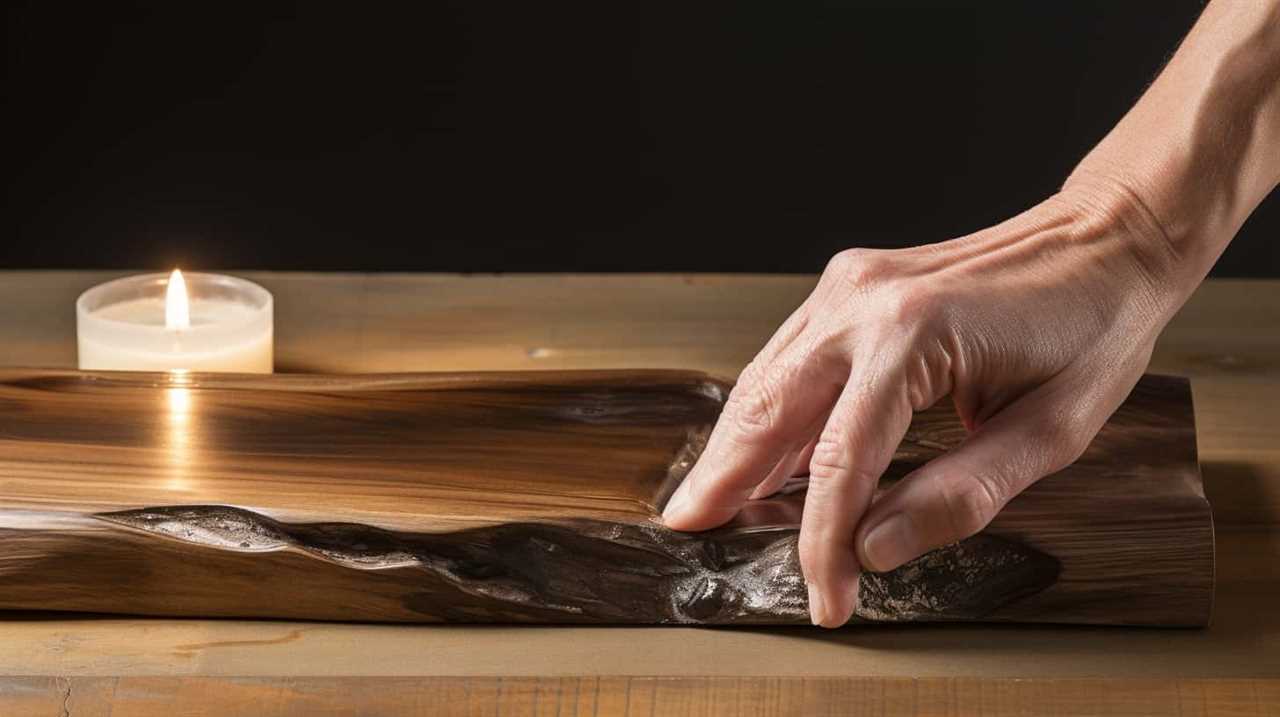
| Flammable Materials | Safe Alternatives |
|---|---|
| Curtains | Flame-resistant curtains or blinds |
| Paper | Digital or electronic substitutes |
| Combustible liquids | Non-flammable alternatives |
Store Candles in a Cool, Dry Place
When storing candles, it’s important to keep them in a cool, dry place to prevent any damage or deterioration. Proper storage techniques can help prevent moisture damage and ensure that your candles remain in good condition for future use. Here are a few reasons why storing candles in a cool, dry place is essential:
- Moisture can cause the wick to become damp, making it difficult to light the candle.
- High humidity can cause the wax to soften or melt, leading to misshapen candles.
- Exposing candles to moisture can also result in discoloration or mold growth.
To protect your candles, store them in airtight containers or sealed plastic bags and keep them away from areas with high humidity, such as bathrooms or basements. By following these proper storage techniques, you can prevent moisture damage and ensure that your candles are ready to burn when you need them.
Now, let’s move on to the next section and explore the importance of following the manufacturer’s instructions for optimal burning.
Follow the Manufacturer’s Instructions for Optimal Burning
Following the manufacturer’s instructions ensures that we achieve optimal burning for our candles. By carefully adhering to these guidelines, we can maximize the lifespan and performance of our candles. One important aspect that the instructions usually cover is wick maintenance. It is crucial to trim the wick to the recommended length before each use to prevent excessive smoke and uneven burning. Additionally, manufacturers often provide tips on preventing candle tunneling, which is when a hole forms around the wick, leaving unused wax along the sides. To avoid this, they may suggest burning the candle for a specific amount of time during each use or using a candle snuffer to extinguish the flame. By following these instructions, we can ensure a safe and enjoyable candle burning experience.
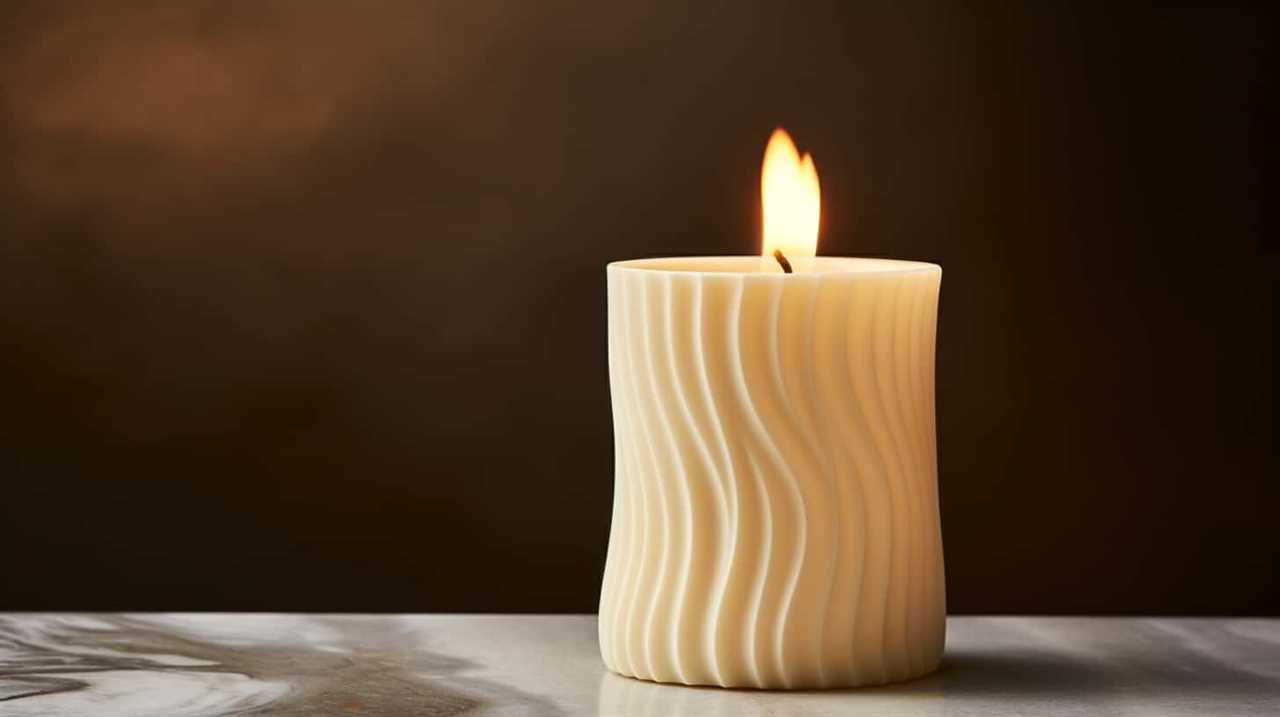
| Manufacturer’s Tips | Benefits of Following Instructions | Common Instructions to Follow |
|---|---|---|
| Wick maintenance | Prevents excessive smoke and soot | Trim wick before each use |
| Preventing candle tunneling | Maximizes candle lifespan | Burn for recommended time |
| Ensures even and efficient burning | Use a candle snuffer to extinguish |
Frequently Asked Questions
How Do I Choose the Right Size Wick for My Candle?
When choosing a wick size for your candle, consider the burn time you desire. A larger wick will burn more wax, resulting in a shorter burn time. Conversely, a smaller wick will burn less wax, prolonging the candle’s lifespan.
Can I Use Regular Scissors to Trim the Wick?
Using proper wick trimmers is recommended for trimming candle wicks. Regular scissors may not give a clean cut, leading to uneven burning. Consider investing in wick trimmers for optimal results.
Is It Necessary to Use a Candle Snuffer to Extinguish the Flame?
Proper candle safety practices include extinguishing the flame before leaving the room. While a candle snuffer is recommended, alternative methods like gently blowing or using a metal spoon can also be used.
Can I Burn Candles in Small Spaces Like Bathrooms?
When burning candles in small spaces, it’s important to take safety precautions. We can ensure proper ventilation and keep flammable objects away. By being mindful of these tips, we can enjoy a cozy ambiance without compromising safety.
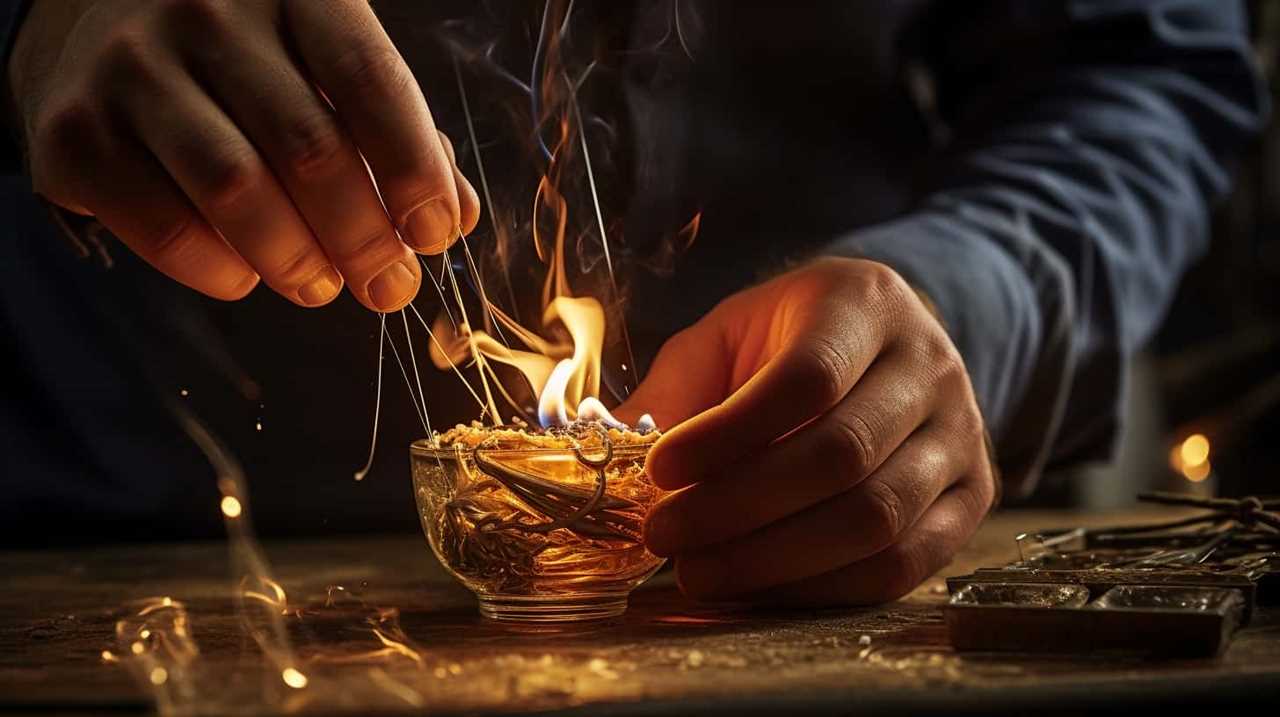
How Should I Store My Candles to Ensure They Last Longer?
Proper candle storage is essential for maximizing their lifespan. By keeping them in a cool, dry place away from direct sunlight, you can prevent melting or warping. Regular candle care and maintenance will also help ensure they last longer.
Conclusion
To prevent a candle wick from drowning, it’s crucial to choose the right size wick, trim it before each use, and position it correctly in the candle. Using a wick trimmer or scissors can help maintain the wick’s length.
Additionally, avoiding drafts, burning candles in small spaces, and keeping them away from flammable materials is essential. By following these tips and storing candles properly, you can ensure optimal burning and enjoy a safe and enjoyable candle experience.
Remember, a well-maintained wick leads to a brighter and longer-lasting flame.

















